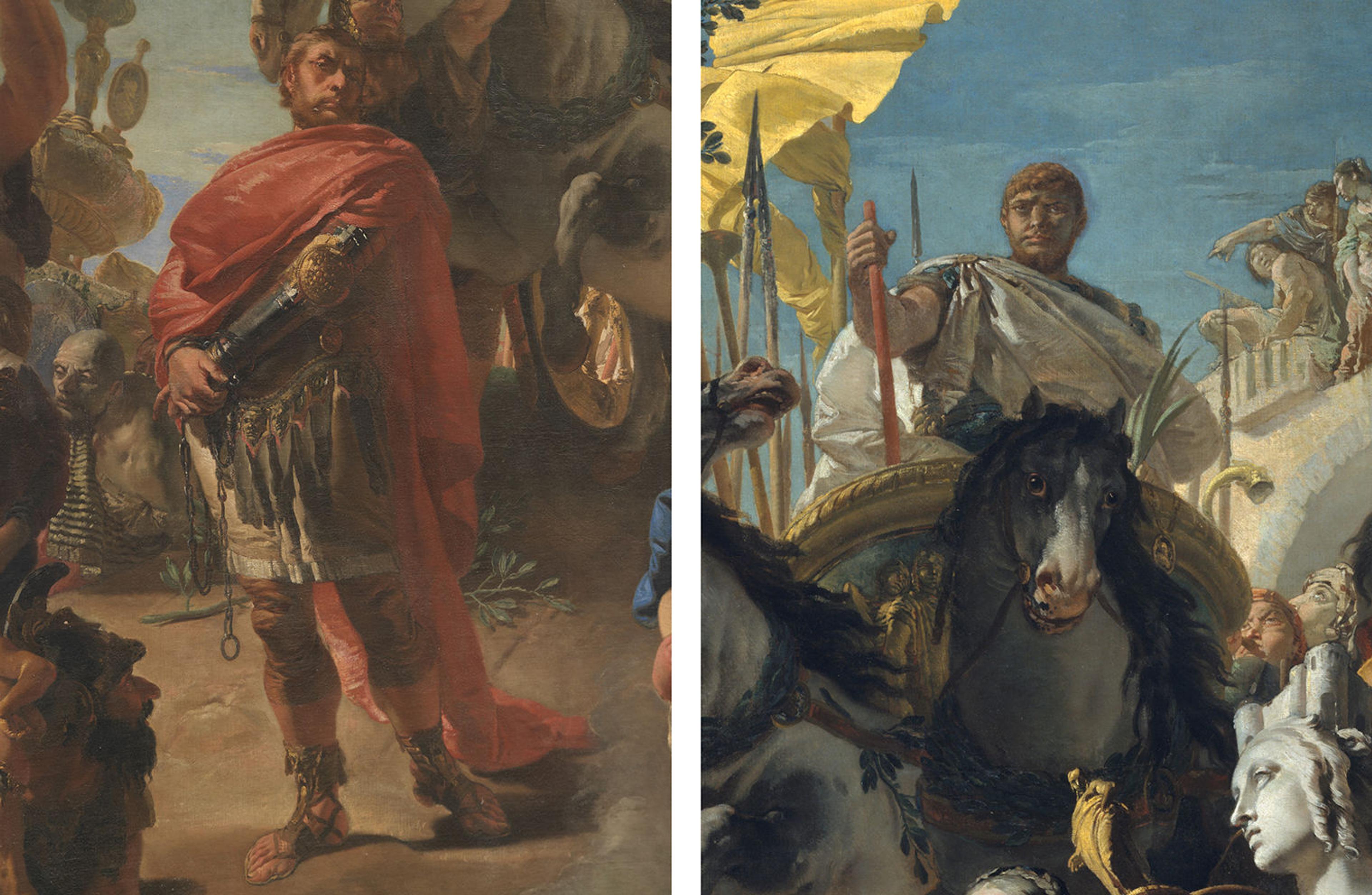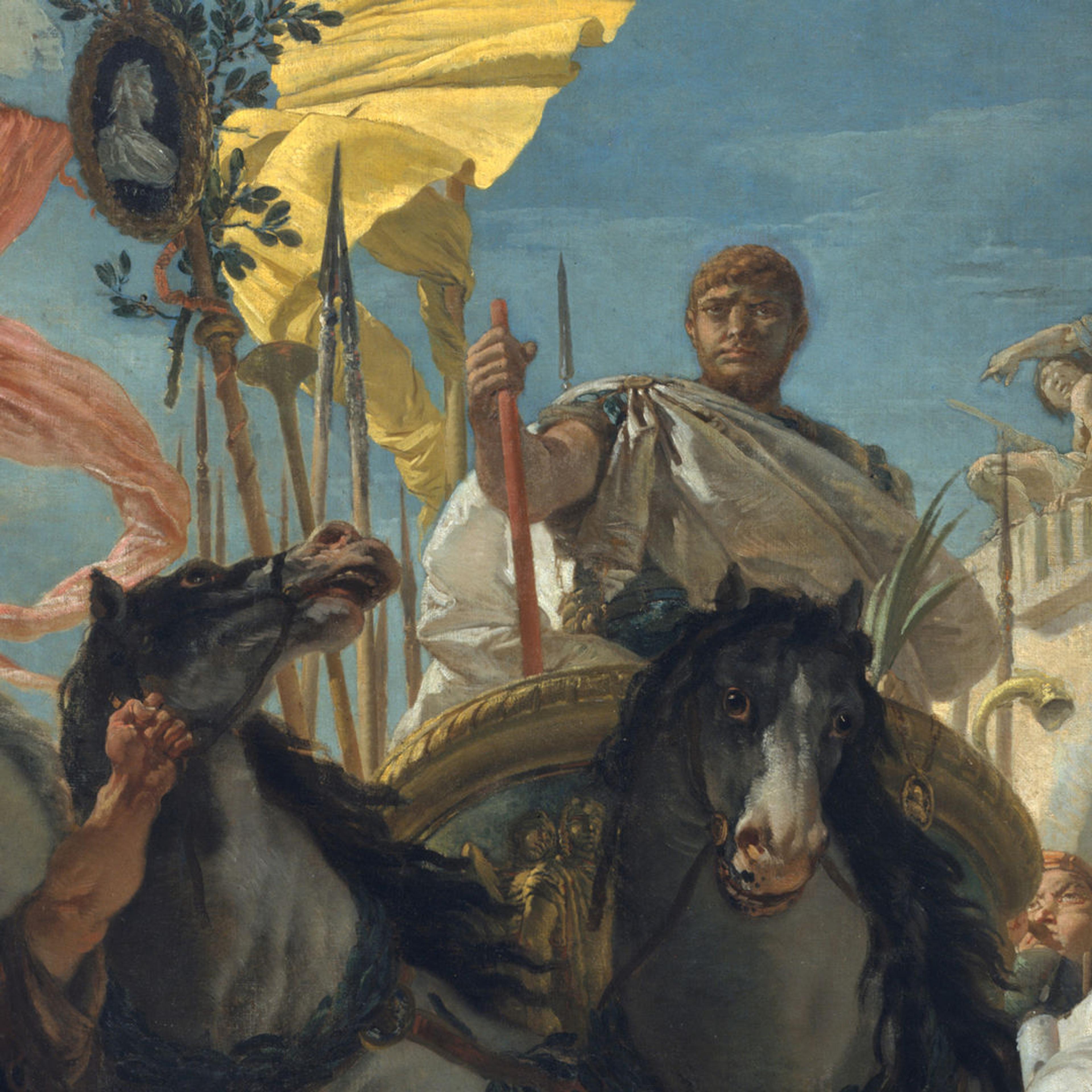How many millions have climbed the Great Staircase since Tiepolo’s The Triumph of Marius (1729) was unrolled from its giant storage drum in Saranac Lake, New York, in 1965, and shipped downstate to The Met? And what do they see when they look up at that dazzling scene tumbling toward them? Beyond the atrium, across the stairwell, the shimmering vanishing point. Marius’s parade, Tiepolo’s parade, and the parade of visitors posing for their phones, Marius and Jugurtha looming behind them, Tiepolo’s epic the backdrop to theirs. Numidia, Rome, Venice, New York, the empires, the spectacle, the gathering storm. Giambattista Tiepolo, “Tiepoletto” as everyone knew him—the colors, the fantasia, the theater, the ambiguities—and after three long centuries, still merely decorative.

Giovanni Battista Tiepolo (Italian, 1696–1770). The Triumph of Marius, 1729. Oil on canvas, 18 ft. 4 in. x 10 ft. 8 5/8 in. (558.8 x 326.7 cm). The Metropolitan Museum of Art, New York, Rogers Fund, 1965 (65.183.1)
“The master of sunny visions,” writes Keith Christiansen in the spring 1998 Met Bulletin, published to mark the restoration and rehanging of those magnificent canvases from the reception room of the Ca’ Dolfin palace off the Grand Canal in Venice, three from a cycle of ten painted between 1726 and 1729 and scattered with the Most Serene Republic’s nineteenth-century decline, these three largest spirited across the Atlantic in 1935 by Stefan Mendl, heir to Vienna’s most popular bakery chain, lying for decades in the dark of that Adirondack storage unit, too big for his Central Park West apartment, the others washing up in the Hermitage and Vienna’s Kunsthistorisches Museum.
Tiepolo blue. Tiepolo pink. Tiepolo’s clouds. Tiepolo’s textiles. Jugurtha’s cape, the fabric so fine it sheens, the crimson so dimensional; Marius’s silver toga billowing behind him snow-blown white—one of how many shades of white in this painting?; the lime-gold tunic on that foregrounded foreshortened little drummer boy, his silken platinum shorts with their yellow gold edging; the deep marine rapture of the wrap worn by that down-glancing woman with the rouged cheeks staring past Jugurtha with… what, contempt? … at the crouched Roman soldier grasping his golden loot against the opposite edge of the frame (the colonial loot somersaulting as if into the museum); the rose and gold banners flowing in a wind that registers nowhere else in the painting. An ecstasy of luxury and color which isn’t even the main theme. And the carnival of expressions: people, animals, statues, equally realized and equally mysterious, a psychic and sensory democracy of self-contained individuals, the erotic intensities of cross-cutting glances and locked eyes.

Giovanni Battista Tiepolo (Italian, 1696–1770). The Triumph of Marius (detail), 1729. Oil on canvas, 18 ft. 4 in. x 10 ft. 8 5/8 in. (558.8 x 326.7 cm). The Metropolitan Museum of Art, New York, Rogers Fund, 1965 (65.183.1)
That commanding woman who is already a Tiepolo type reappearing a few steps away in Gallery 642 as the Barbaro Ceres, reclined in splendor, hand on hip, cornucopia spilling from the ceiling in yet more pictorial extravagance. That drummer boy who mimics Jugurtha’s pose and looks back toward him, though maybe not, maybe at that older boy across the frame who, in turn, seems to be looking into the eyes of the white-turbaned man obscured by the semi-naked athlete running away with the largest pot of all. And those human and nonhuman eyes that stare directly into ours: Marius, Jugurtha, the carved bust atop the standard on the extreme right, the two rightmost horses, and, in his very un-Roman painting cap, Tiepolo, beside Jugurtha, their eyes aligned, their expressions calm, demanding, but unreadable. All excess but all contained. What at first seems chaotic action slowly resolving into stillness and interiority, as if all balanced, stop-motion, on the edge of something enormous and unknown: the world that comes after the war.

Giovanni Battista Tiepolo (Italian, 1696–1770). The Triumph of Marius (detail), 1729. Oil on canvas, 18 ft. 4 in. x 10 ft. 8 5/8 in. (558.8 x 326.7 cm). The Metropolitan Museum of Art, New York, Rogers Fund, 1965 (65.183.1)
“O venal city! doomed to quick perdition, could but a purchaser be found!” exclaimed Jugurtha (according to Livy). Jugurtha who saw that “at Rome everything was for sale” (according to Sallust), who held up a mirror to the Republic revealing its deep-seated decay, sowing the seeds from which Marius (“an ambitious man loath to share his glory with another,” according to Plutarch) rose on the acclaim of the plebs (“the first time that the haughtiness of the nobility was confronted,” says Sallust) to inaugurate the descent into autocracy, the long, brutal decline from Republic to civil war to empire—from imperfect democracy to Caesar and Octavian—that begins with Marius returning from Numidia and his parading of the betrayed North African king through the streets of Rome in chains.

Entry to the European Paintings galleries (Gallery 600). Tiepolo’s The Triumph of Marius (65.183.1) at center. The Metropolitan Museum of Art. November 2023
And this Jugurtha—Tiepolo’s Jugurtha, painted for the Dolfin family whose scion, the procurator Daniele IV, fought in the Morean War against the Ottoman empire, destroying the Parthenon in the process—Jugurtha in chains yet looking every inch the victor; Marius, astride his chariot but far from dominant; Jugurtha, not an honorable man by any extant accounts, a man who sought power by whatever means, a man no better than the Romans he fought but at least a man who fought, and who, by elevating Marius and Sulla as the only consuls able to outthink him and resist his bribes also hastened the downfall of the Roman republic; this Jugurtha, after Marius’s triumph, “was cast into prison, where some tore his tunic from his body, and others were so eager to snatch away his golden ear-ring that they tore off with it the lobe of his ear, and when he had been thrust down naked into the dungeon pit … after struggling with hunger for six days and up to the last moment clinging to the desire of life, paid the penalty which his crimes deserved” (says Plutarch). But this bewildered, fearful Jugurtha bequeathed by Plutarch is not the man shown at the still center of Tiepolo’s painting. Instead, the bewildered and fearful are the spectral prisoner (war’s living-dead defeated) just visible between Jugurtha and Tiepolo, and those others—also leaching color—perched atop the rampart, clutching their children as the triumph unfolds and the army strides in, understanding all at once, as the rest of us do now too, that we are not spectators before History’s stage but instead participants, willing or not, unarmed and wide open to this unforgiving world and the uncertainties it brings.
